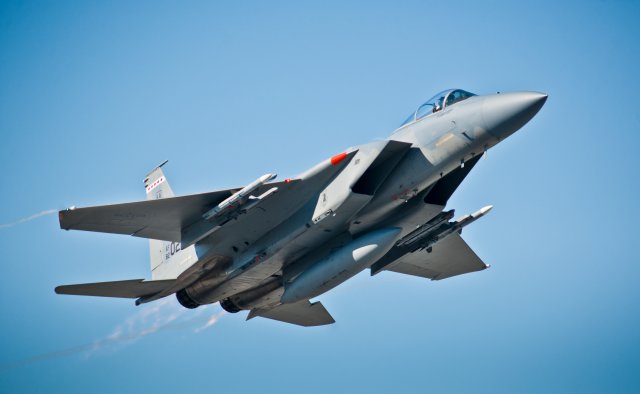USAF F-15 unit complete flight tests with new ADCP II computer operating system
| a | |||
|
|
|||
|
Aviation defence equipment technology - United States
|
|||
|
|
|||
|
USAF F-15 unit completed flight tests with new ADCP II computer operating system
|
|||
|
USAF Eglin's Operational Flight Program Combined Test Force completed a historic test mission here July 8 on an aircraft system that will enhance the life and lethality of the F-15, the Egline public affaires team announced on the airbase website.
|
|||
|
|
|||
 Maj. Justin Elliott, 40th Flight Test Squadron F-15 flight commander, prepares to deplane after he piloted the first F-15 equipped with the Advanced Display Core Processor II July 8 at Eglin Air Force Base, Fla. Maj. Justin Elliott, 40th Flight Test Squadron F-15 flight commander, prepares to deplane after he piloted the first F-15 equipped with the Advanced Display Core Processor II July 8 at Eglin Air Force Base, Fla. (Credit: USAF/1st Lt. Daniel Lee) |
|||
|
|
|||
|
The first-ever flight equipped with the Advanced Display Core Processor II tested the aircraft’s flight safety, in-flight refueling and basic landing capabilities over Eglin’s water and land ranges.
“We were not only the first unit in the Air Force to fly it, we were the first unit in the world to fly it,” said Maj. Justin Elliott, the experimental test pilot, who flew the ADCP II’s maiden flight. The ADCP II computer operating system controls all displays, basic flight instruments, caution and warning capabilities, cooling and heating and every weapon and targeting system in the jet, according to Elliott, the 40th Flight Test Squadron F-15 flight commander. “As our offensive and defensive systems continue to evolve, more processing power is required to control them,” said Elliott. “It’s been over a decade since the F-15 fleet received a new central processor, and in that window, we’ve added nearly $10 billion in new sensors, weapons and systems.” Though the oldest of Eglin’s F-15s are 30 years old, the Boeing-developed processor allows users to expand their capabilities further through 2040. “This processor will allow us to drive a new defensive suite, an entirely new cockpit of displays, and a significant number of future additions to the jet that have not even been designed yet,” said Elliott. The OFP CTF’s mission is crucial to supporting the F-15 lifecycle. The unit has been managing the ADCP II test program since its preliminary stages in 2011, to include involvement in the program’s hardware and software development, according to Craig Franke, OFP CTF senior test engineer. “Until the processor’s stability is demonstrated, we will be the sole unit managing the program’s development alongside the 40th FLTS executing the ADCP II flight test program,” said Franke. The ADCP II flight test was hailed a success and was put back in the air just a week later to continue the program’s test timeline of approximately 120 test missions on the F15E and F-15C combined. “The system’s capabilities exceeded our expectations and brought us home safely,” said Elliott. “Like all new things, we will have problems to fix and things to improve, but I have every confidence this system will take us into the future.” Simply put, Elliott assures age is just a number when it comes to the F-15. “I pity the first enemy fighter who meets an ADCP II F-15 and thinks it’s a legacy fighter,” said Elliott. “They will be in for a sore disappointment.” A lynchpin technology, the ADCP II is the line leader in a domino-effect of F-15 upgrades that will enhance radar and warning system capabilities for the entire F-15 fleet, according to Franke. As the US Air Force’s only dual-major command squadron under Air Force Material Command and Air Combat Command, the OFP CTF manages the end-to-end developmental and operational test requirements for all F-15 software and hardware changes. “The F-15 is undergoing a modernization surge that will see us test and field the most systems in the history of the aircraft,” said Lt. Col. Michael Lynch, OFP CTF commander. “On top of the ACDP II, major programs we’re managing include a datalink capability, infrared search and track sensor and defensive electronic warfare capability.” The OFP CTF is made up of aircrew, engineers, program managers, and analyst, information technology, maintenance, and security personnel. They also team up with other base units, including the 40th FLTS and 85th Test and Evaluation Squadron, and geographically separated units at Nellis Air Force Base, Nev., to form an integrated test team. “We’re the backbone that ensures the F-15 continues to be the cornerstone that provides combat airpower for America,” said Lynch. “We support the warfighter through our ability to bring new and emerging capabilities to the aircraft - the better we can integrate the F-15 inside and out, the more options we provide the combatant commander.” |
|||
|
|
|||
 A 40th Flight Test Squadron F-15 soars up upon takeoff from the Eglin Air Force Base runway for a morning sortie. The 40th FTS Airmen fly operational test missions in the F-16, F-15 and A-10. The 40th FTS is a squadron in the 96th Test Wing A 40th Flight Test Squadron F-15 soars up upon takeoff from the Eglin Air Force Base runway for a morning sortie. The 40th FTS Airmen fly operational test missions in the F-16, F-15 and A-10. The 40th FTS is a squadron in the 96th Test Wing(USAF/Samuel King Jr.) |
|||


























